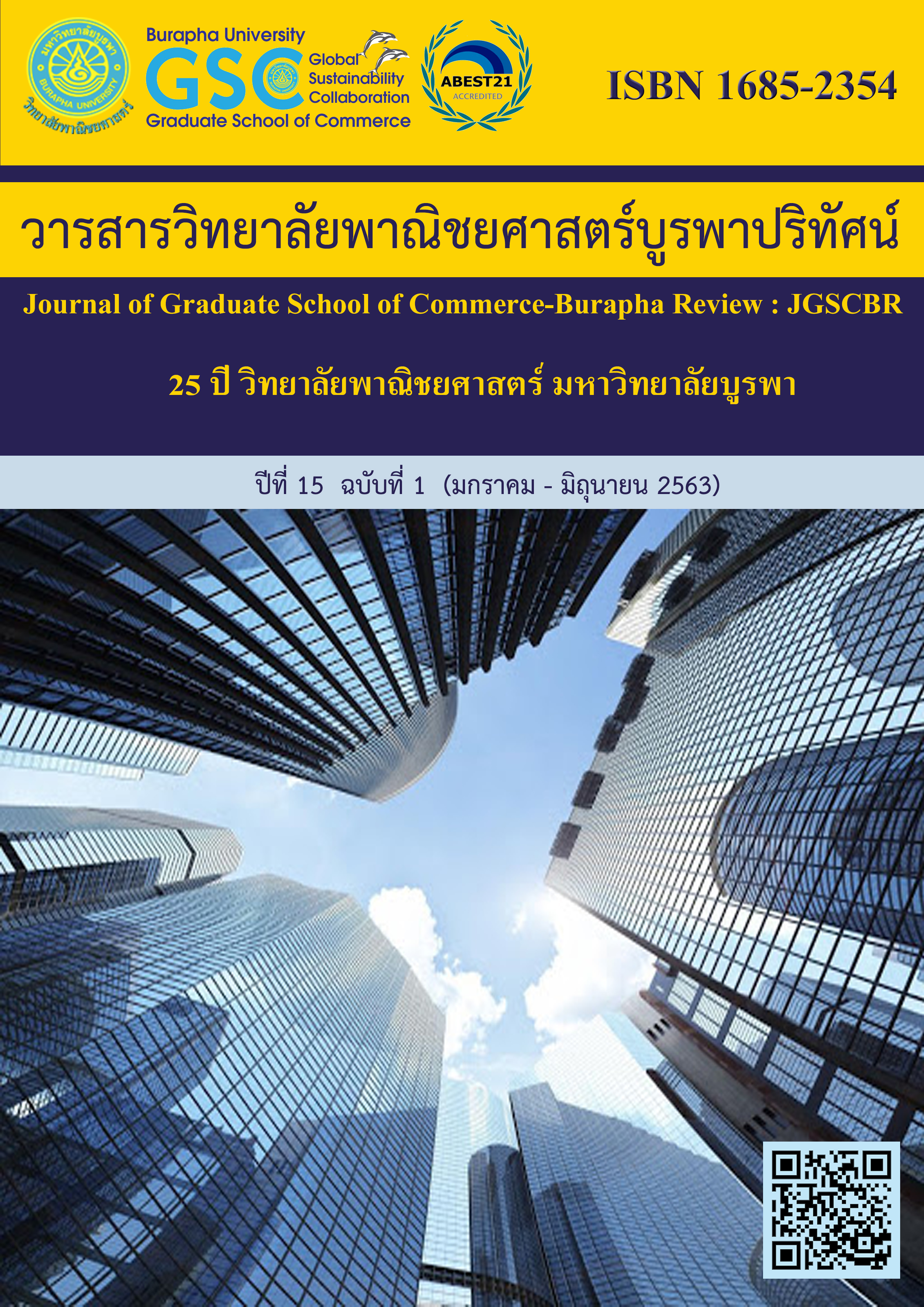SERVICE QUALITY ON SERVICE’S TRADESHOWS PERFORMANCE IN THAILAND
Main Article Content
Abstract
The objective of this research was the created the model of Service Quality on Service’s Tradeshows Performance in Thailand. This research was a mixed-method research. Questionnaires were used for data collection. The population in this research included 450 entrepreneurs and executives of tradeshow agencies in Thailand. Structural equation modeling (SEM) was applied for data analysis.
According to hypothesis testing, it was found that the factor in term of knowledge of tradeshows, tradeshow service, and space management had direct positive influences towards service quality of tradeshows and tradeshow service performance. It was also found that the factor in term of service quality of tradeshows had positive influences towards tradeshow service performance, which was an effect size with the statistical significance of .01.
Article Details
The owner of the article does not copy or violate any of its copyright. If any copyright infringement occurs or prosecution, in any case, the Editorial Board is not involved in all the rights to the owner of the article to be performed.
References
A.Poorani, A. (1996). "Trade-show management: Budgeting and planning for a successful event." The Cornell Hotel and Restaurant Administration Quarterly. 37(4) : 77-84.
Adams, C. (2016). "Play by the Rules Before heading to your next U.S. trade show, familiarize yourself with some of the most common rules governing the exhibit hall." [Online]. Available : http://www.exhibitoronline.com/topics/article. asp?ID=1435. Retrieved 20 July 2017.
Armstrong, L. (2015). "Floor plan fundamentals. " [Online]. Available :
http://www.exhibitoronline.com/topics/article.asp?ID=906. Retrieved 20 July 2017.
Barnes, S. J., Scornavacca, E. and Innes, D. (2006). "Understanding wireless field force automation in trade services." Industrial Management & Data Systems. 106(2) : 172 – 181.
Baumgartner, C. (2016). "SCIENCE OF AN EXHIBITION FLOOR PLAN." [Online]. Available :
http://www.tsnn.com/blog/science-exhibition-floor-plan.
Retrieved 22 December 2017 2017.
Bitner, M. J. (1992). "Servicescapes: The Impact of Physical Surroundings on Customers
and Employees." Journal of Marketing. 56(2) : 57.
Biz Tradeshows. (2011). "B2B Trade Fairs vs B2C Trade Fairs." [Online]. Available :
www.biztradeshows.com/articles/b2b-trade-fairs-b2c-trade-fairs.html Retrieved 20 May 2016.
Black, R. (1986). "The Trade Show Industry: Management and Marketing Career Opportunities." Trade Show Bureau, East Orleans, MA.
Bruhn, M. and Hadwich, K. (2005). "Managing the service quality of trade fairs”, M. Kirchgeorg (Ed.), Trade show management: in Planning, implementing and controlling of trade shows conventions and events Gabler Verlag. : 787-821.
Deshpande, R., Farley, J. and Webster, F. E. (1993). "Corporate culture, customer orientation and innovativeness in Japanese firms: a quadrad analysis." Journal of Marketing.57: 23-37.
Diaz Ruiz, C. and Holmlund, M. (2017). "Actionable marketing knowledge: A close reading ofrepresentation, knowledge and action in market research." Industrial Marketing Management. 66 : 172-180.
Ducate, D. L. (2001). "The Role of B to B Exhibitions in Bringing Products to Market." Center of Exhibition Industry Research, CEIR, Dallas, TX.
Gopalakrishna, S. and Lilien, G. (2010). "A three-stage model of industrial trade show performance." Marketing Science. 14(1) : 22-42.
Gronroos, C. (1990). "Service Management: A Management Focus for Service Competition." Service Industry Management. 1(1) : 6 - 14.
Kotler, P. and Keller, K. L. (2009), Marketing management.
Lin, Y., Kerstetter, D. and Hickerson, B. (2015b). "Developing a Trade Show Exhibitor ’s Overall Satisfaction Measurement Scale." [Online]. Available :http://scholarworks.umass.edu/ttra. Retrieved 29 March 2018 2018.
Parasuraman, A., Berry, L. L. and Zeithaml, V. A. (1991). "Refinement and reassessment of the SERVQUAL scale." Journal of Retailing. 67(4) : 420-450.
Parasuraman, A., V.A, Z. and Berry, L. L. (1988). "SERVQUAL: a multiple-item scale for measuring consumer perceptions of service quality." Journal of Retailing. 64(1) :12-40.
Rodríguez, A., Reina, M. D. and Rufín, R. (2015). Relationship quality and exhibitor's performance in leisure trade shows. Technicka Univerzita Liberci.
Smith, P. (2014). "Project Cost Management – Global Issues and Challenges." Procedia - Social and Behavioral Sciences. 119 : 485-494.
Trade Show Advisor. (2017), "TRADE SHOW EXPENSES KNOW THESE 5 DIFFICULT COSTS TO CONTROL." [Online]. Available : http://www.trade-show-advisor.com/trade-show-expenses.html .accessed August, 25 2017.
Trade Show Bureau. (1988b). "Exhibitors - their trade show practices." in.
Trade Show Bureau. (1992). "Newsletter." in, June, Springs Co, CO.
Trade Show Bureau. (1994). "A Guide to the U.S. Exposition Industry." in. Trade Show Bureau Resource Center, Denver, CO.
Vichit. U-on (2011). "Global strategic planning for international business company." Journal of Global Business Review. 2(2) : 45-52.
Pichai Phanwattana, Vichit U-on. (2017). A literature review of strategic human resource management. Silpakorn University Journal of Social Sciences, Humanities, and Arts,17,23-40.
Whitfield, J. and Webber, D. J. (2011). "Which exhibition attributes create repeat visitation?." International Journal of Hospitality Managementl. 30(2) : 439-447.
Williams, J. D., Gopalakrishna, S. and Cox, J. M. (1993). "Trade show guidelines for smaller firms." Industrial Marketing Management . 22 : 265-275.


